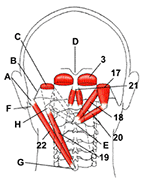 The trick to finding what is supposed to be the soft tissue is to first locate a nearby bony landmark that can be easily felt from the surface. If you place your finger tip behind an earlobe, you will find a "gully" formed by the jaw bone in front and another bone in back, the mastoid bone. Running your finger down that edge will quickly bring you to the bottom tip of the mastoid (A). Continuing on around the tip and following the back edge (B) will bring you to a bone-like ridge (C) about 1¼ to 1½ inch above the tip of the mastoid. This ridge is the attachment line of Obliquus Capitis Superior (17). If you follow the ridge straight in toward the center of the head, you will feel it come to an end a little over an inch from where you started. At that point, your finger should pick out the upper end of the hard center of Rectus Capitis Posterior Major (18). Follow a line angled about 45° downward to the ridge of 17, to find the lower end of 18, or place your finger tip on the point of the inion bone (D), located at the back of your head. Move your finger straight down until you feel a depression below the edge of the skull, followed by the backward protrusion of a vertebra. This is the 2nd (cervical) vertebra below the skull, as the 1st vertebra does not have a backward protrusion which can be felt from the surface. The protrusion is split so it forms twin lumps on each side of the center line (E), about 2¼ to 2½ inches below the point of the inion. In addition to being the attachment of the lower end of 18, this is the inner attachment of Obliquus Capitis Inferior (20). The trick to finding what is supposed to be the soft tissue is to first locate a nearby bony landmark that can be easily felt from the surface. If you place your finger tip behind an earlobe, you will find a "gully" formed by the jaw bone in front and another bone in back, the mastoid bone. Running your finger down that edge will quickly bring you to the bottom tip of the mastoid (A). Continuing on around the tip and following the back edge (B) will bring you to a bone-like ridge (C) about 1¼ to 1½ inch above the tip of the mastoid. This ridge is the attachment line of Obliquus Capitis Superior (17). If you follow the ridge straight in toward the center of the head, you will feel it come to an end a little over an inch from where you started. At that point, your finger should pick out the upper end of the hard center of Rectus Capitis Posterior Major (18). Follow a line angled about 45° downward to the ridge of 17, to find the lower end of 18, or place your finger tip on the point of the inion bone (D), located at the back of your head. Move your finger straight down until you feel a depression below the edge of the skull, followed by the backward protrusion of a vertebra. This is the 2nd (cervical) vertebra below the skull, as the 1st vertebra does not have a backward protrusion which can be felt from the surface. The protrusion is split so it forms twin lumps on each side of the center line (E), about 2¼ to 2½ inches below the point of the inion. In addition to being the attachment of the lower end of 18, this is the inner attachment of Obliquus Capitis Inferior (20).
Go back to the tip of the mastoid and again run your finger tip up the back edge, but this time press in a bit and you will feel that your are passing over the end of a muscle (F). This is the upper end of Longissimus Capitis (22). To find the lower end, go back to the twin tipped vertebra where 18 and 20 attach, and run your finger straight down toward the base of the neck. You will feel several vertebrae pass under your finger and then you will come to one that sticks out much further than the others (G). This is C7, the "crick in the neck" area, or the 7th cervical vertebra, which is the attachment for the lower end of Longissimus Cervicis (19) and 22.
Pulse Trapezius attachment at inion (3) for sinus problems; it lies on top of 18.
Pulse 17 for frontal sinus; work the lower end for nausea, the inside edge for pain over the eyes.
Pulse 22 for a stiff neck.
Pulse 18 to relieve the irritation of the sphenoid sinus and return the pituitary and hypothalamus to normal functioning.
All of the suboccipital muscles should be pulsed to help with general health, well being, and energy levels.
As the treatments take effect, the soreness decreases.
|

